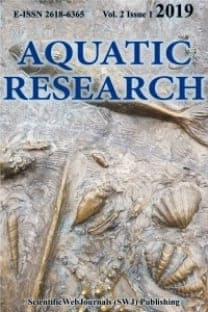TRACE TOXIC MINERAL LEVELS OF SEA LETTUCE (Ulva spp.) FROM COAST OF ISTANBUL
___
AquaMaps (2016a). Computer generated distribution maps for Ulva lactuca (Sea lettuce), with modelled year 2100 native range map based on IPCC A2 emissions scenario. www.aquamaps.org, version of Aug. 2016. https://www.aquamaps.org/imagethumb/file_destination/pic_SLB-143238.jpg and https://www.sealifebase.ca/summary/Ulva-lactuca.html (accessed 24.03.2019)AquaMaps (2016b). Computer generated distribution maps for Ulva rigida, with modelled year 2100 native range map based on IPCC A2 emissions scenario. www.aquamaps.org, version of Aug. 2016. Web. Accessed 5 May 2019 from https://www.aquamaps.org/imagethumb/file_destination/pic_SLB-143769.jpg and https://www.sealifebase.ca/summary/Ulva-rigida.html (accessed 05.05.2019)
Belitz, H. D., Grosch, W., Schieberle, P. (2009). Food chemistry. Food Chemistry (4th ed.). Berlin Heidelberg: Springer-Verlag. https://doi.org/10.1007/978-3-540-69934-7
Culha, S.T., Kocbas, F., Gundogdu, A., Culha, M. (2013). Heavy metal levels in marine algae from Marmara Sea and Mediterranean Sea. In Mediterranean Science Comission, 40th CIESM Congress. Marsilya.
Davis, T.A., Volesky, B., Mucci, A. (2003). A review of the biochemistry of heavy metal biosorption by brown algae. Water Research, 37, 4311-4330. https://doi.org/10.1016/S0043-1354(03)00293-8
Ergul, H.A., Ay, U., Karademir, A., Cayir, B., Topcuoglu, S., Telli, B., Terzi, M. (2010). Heavy metal concentrations in biota , sediment and sea water samples from Dil Iskelesi region. In Rapp. Comm. int. Mer Médit (p. 246). Venice.
NMKL (Nordic Committee on Food Analysis). (2007). As, Cd, Hg, Pb and other elements determination by ICPMS after pressure digestion, No:186. Özcan, M. (2004). Mineral contents of some plants used as condiments in Turkey. Food Chemistry, 84(3), 437-440. https://doi.org/10.1016/S0308-8146(03)00263-2
Ozyigit, I.I., Uyanik, O.L., Sahin, N.R., Yalcin, I.E., Demir, G. (2017). Monitoring the pollution level in Istanbul coast of the sea of Marmara using algal species Ulva lactuca L. Polish Journal of Environmental Studies, 26(2), 773-778. https://doi.org/10.15244/pjoes/66177
Soylak, M., Saraçoǧlu, S., Tüzen, M., & Mendil, D. (2005). Determination of trace metals in mushroom samples from Kayseri, Turkey. Food Chemistry, 92(4), 649-652. https://doi.org/10.1016/j.foodchem.2004.08.032
Tchounwou, Paul B., Yedjou, Clement G., Patlolla, Anita K., Sutton, D.J. (2012). Molecular, Clinical and Environmental Toxicology. National Institures of Health Public Access, 101(August), 133-164. https://doi.org/10.1007/978-3-7643-8338-1
Topcuoğlu, S., Kılıç, Ö., Belivermiş, M. (2010). Use of marine algae as biological indicator of heavy metal pollution in Turkish marine environment. Journal of the Black Sea/Mediterranean Environment, 16(1), 43-52.
Villares, R., Puente, X., Carballeira, A. (2010). Ulva and Enteromorpha as Indicators of Heavy Metal Pollution. Hydrobiologia, 462, 221-232. https://doi.org/10.1023/A:1013154821531
- ISSN: 2618-6365
- Yayın Aralığı: 4
- Başlangıç: 2018
- Yayıncı: Nuray ERKAN ÖZDEN
FIRST RECORD OF Jujubinus errinae OUTSIDE OF THE TYPE LOCALITY
Salvatore GİACOBBE, Walter RENDA
MACHINE LEARNING APPLICATIONS IN OCEANOGRAPHY
Tuğba ŞENTÜRK, Muhammet Burak BATIR, Çisil ÇAMLI, Şükran YILDIZ
Çiğdem Cahide YIĞIN, Fikret ÇAKIR, Koray CABBAR, Bayram KIZILKAYA, Hasan Basri ORMANCI, Alkan ÖZTEKİN, Yeliz ÖZÜDOĞRU
TRACE TOXIC MINERAL LEVELS OF SEA LETTUCE (Ulva spp.) FROM COAST OF ISTANBUL
Özkan ÖZDEN, Yasin ORHAN, Muammer KAPLAN, Seyfettin PARILDAR, Erkan Nuray ÖZDEN
